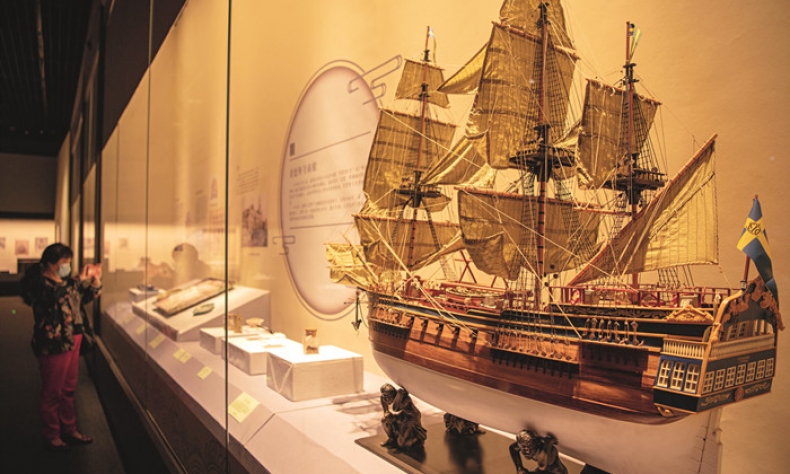Historical Linkages

The Maritime Silk Road has facilitated China-Africa contacts since ancient times.
China-Africa relations have deep roots in the past. There were two main trade networks that were conducive to contact between China and Africa: the continental Eurasian Silk Road and the Maritime Silk Road. The Maritime Silk Road that stretched from Hangzhou in east China’s Zhejiang Province to East Africa along the northern shore of the Indian Ocean ran parallel with and was connected to the continental Eurasian Silk Road.
Ancient Silk Road and Africa
The silk industry, trade, and consequently the Silk Road are much older than previously thought and probably reached Egypt through Persia. Trade and cultural exchanges between China and Egypt were well established during China’s Han Dynasty (206 B.C.-A.D. 220).
Chinese copper coins bearing the Kaiyuan reign mark of the Tang Dynasty (618-907) were found at several island and coastal port sites – for instance, at Mogadishu and Zanzibar Island. These Kaiyuan coins were made not only under the Kaiyuan reign (713–741), but later in the eighth century as well. They remained valid for exchange in China throughout the Tang Dynasty.
The bulk of ancient Chinese trade with Africa was however represented by ceramics. Evidence of Chinese material culture has been recorded along the eastern flank of the continent, from Egypt to Mozambique, Zimbabwe and South Africa, along the coast as well as in the hinterland. During the Southern Song Dynasty (1127-1279), Fujian Province witnessed an “industrial revolution” with the invention and spread of the “dragon kilns.” Green ware (celadon) was one of the dominant specialties of Minbei and Minnan (northern and southern parts of Fujian) that was exported all along the Maritime Silk Road through Xiamen and Zhangzhou trade hubs.

Peaceful maritime navigation
In the first half of the 15th century, the Ming Dynasty (1368-1644) witnessed frequent voyages along the Maritime Silk Road. The Treasure Fleet sailed to the East African coast in the fourth (1413-1415), fifth (1416-1419), and sixth (1421-1422) voyage, docking at Mogadishu in present-day Somalia, and Malindi and Mombasa in present-day Kenya. They exchanged Chinese goods for African ones, including live animals like zebras and giraffes. In addition, some of the descendants of Chinese sailors from Admiral Zheng He’s fleet live today in the small island of Pate along the Kenyan coast.
In summary, there is scattered but significant evidence of the presence of Chinese goods and people in Africa, and African people and animals in China since ancient times. These interactions started in the early first millennium B.C., became more frequent with time through the Han, Tang, Yuan (1279-1368) and Ming dynasties. They peaked in the 15th century and were cut short by an imperial ban on foreign trade. Available data thus provide ample and significant evidence of interactions between China and Africa. Discovering additional evidence in new sites is always interesting. Research has to be intensified to make more discoveries. It expands knowledge and helps tracing the contours of the overlapping spheres of interaction and their cultural implications.
The China-Africa interaction in ancient times was paradigmatically different from the Africa-Europe one. The difference between the experiences of Europe and China were economic and cultural rather than technological. China was not interested in the exploitation of the resources of foreign lands and the control of their populations. The seven voyages of the Treasure Fleet were meant to display Chinese might to all the kingdoms, exchange presents and trade in ports of the Indian Ocean, and bring back exotic toys and novelties for the emperors. The Ming halted these voyages in 1433.
Dynamic China-Africa relations resumed in the late 1950s after the foundation of the People’s Republic of China in 1949, and deepened during the past decade through the Belt and Road Initiative (BRI). Today, 52 African countries and the AU Commission have joined the BRI that aimed at increasing connectivity between cooperating nations through infrastructure construction and the promotion of sustainable economic development. Such infrastructure construction projects include railways, roads, ports and pipelines. As far as the blue economy is concerned, collaboration between BRI countries designed to enhance environmental policies and sustainable exploitation of marine resources has been initiated, as reflected in the Xiamen-Nice-Durban Dialogue.
The author is a professor at the School of Sociology and Anthropology of Xiamen University.
 Facebook
Facebook
 Twitter
Twitter
 Linkedin
Linkedin
 Google +
Google +










